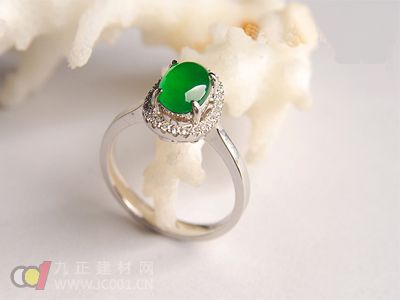Jade with collectible value:
Emerald
When examining the polished surface of natural jade, you'll notice a fine and smooth texture with a strong glassy luster that has a slight oily sheen. Under close inspection, you may observe a complex, piebald-like structure formed by interwoven minerals. In a genuine emerald, the phenocryst particles are usually uniform in size, while small white fibrous crystals—commonly referred to as "stone flowers"—are often visible, ranging from translucent to opaque.
Another way to identify authentic jade is by sound. If you gently tap it, natural jade produces a clear, crisp, and slightly sweet sound. On the other hand, fake or treated jade tends to make a dull, muffled noise.
Additionally, jadeite has a high density, which gives it a noticeable weight when held in your hand. You’ll also feel a cool, dense sensation when rubbing it. If you drip water on its surface, the water droplets will bead up and remain elevated for a short time due to its high water retention.
Hetian Jade
Hetian jade is known for its heavy feel and specific gravity, which ranges between 2.9 and 3.1. When held up to a light source, it can be semi-transparent to the naked eye, and you may even see the shadow of your finger through it. However, counterfeit Hetian jade often appears murky and lacks clarity, even under light.

Due to its high hardness, Hetian jade won’t scratch easily. A simple test involves using a small knife to lightly etch the surface—if it doesn’t show any marks, it’s likely real. If it does scratch, it’s probably not genuine. Also, fake Hetian jade often shows signs of tool wear, such as visible grooves, but lacks the natural "sweat pores" or "small sand eyes" found in real stones.
Dushan Jade
Dushan jade differs from other types of jade in its mineral composition and structure. It consists of multiple minerals and colors, including white (plagioclase, zoisite), green (chrome mica, diopside, hornblende), black (biotite), and yellow, brown, or red minerals. These create a variety of patterns such as plaque-like, bean-shaped, striped, or banded structures. Some pieces resemble white cauliflower, green tofu, or black speckles, making it distinct from other jade varieties.
The color of Dushan jade is quite diverse, and Nanyang green jade, a type of Dushan jade, can vary greatly in tone. It often contains yellow and black components. When examined under a magnifying glass, Dushan jade shows a granular structure, with green minerals appearing in flaky shapes rather than fibrous patterns. Its "jade flower spots" consist of small, transparent green crystals. Unlike jadeite, Dushan jade has a lower specific gravity (2.73–3.18) and a Mohs hardness of 6–6.5, giving it a different luster compared to the glassy and pearly shine of jadeite.
(Word count: 512)JIANGSU CHENG AO METAL TECHNOLOGY CO., LTD , https://www.chengaostainlesssteel.com